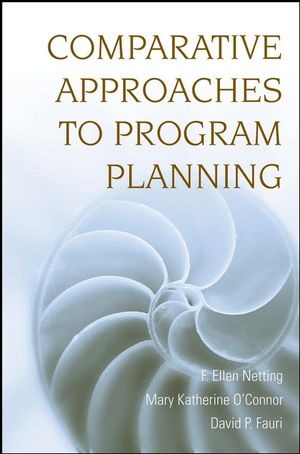|
Textbook
Comparative Approaches to Program PlanningISBN: 978-0-470-12641-7
Paperback
320 pages
February 2008, ©2008
 |
||||||
Preface xiii
Acknowledgments xxiii
Chapter 1 Differences Between Lines and Circles 1
Lines and Circles as Planning Metaphors 5
A Brief History of Lines and Circles 7
Planning Theory: Both Lines and Circles 16
Examples of Planning Approaches 20
The ‘‘Surety’’ of the Line and the ‘‘Tentativeness’’ of the Circle 24
A Conceptual Framework 25
Summary 27
Discussion Questions 28
Chapter 2 Programs: Containers for Idea Implementation 31
Programs and Projects; Services and Interventions 32
Programs and Projects 36
Services and Interventions 38
Programs in Organizational Context 39
Program Planning 43
Mandates and Initiatives 44
Planning Different Types of Programs 46
Summary 48
Discussion Questions 49
Case Exercise: Chronic Pain 51
Chapter 3 Rational Planning and Prescriptive Approaches 59
Case: The Mayor and the Street Educators 61
Introduction 69
History of Rational Planning and Prescriptive Approaches 71
Dimensions of Rational Planning and Prescriptive Approaches 75
The Logic Model 75
Assessing Needs 78
Defining and Analyzing Problems 80
Selecting Intervention Strategies 82
Writing Goals and Objectives 87
Program Design and Decision-Making 91
Accountability in a Prescriptive Approach 96
Accountability Challenges 97
Information Systems 100
Budgeting 103
Rational Planning 104
Mind-sets 104
Skills 106
Strengths and Challenges of Rational Planning 110
Summary 112
Discussion Questions 114
Chapter 4 Interpretive Planning and Emergent Approaches 117
Case: The Invisible People and the Area Agency on Aging 119
Introduction 126
History of Interpretive Planning and Emergent Approaches 129
Dimensions of Interpretive Planning and Emergent Approaches 133
The Logic of Emergence 133
Engagement 138
Discovery 144
Sense-making 146
Unfolding 148
Accountability in an Emergent Approach 155
Accountability Challenges 156
Accountability Options 157
Interpretive Planning 162
Mind-sets 163
Skills 164
Strengths and Challenges of Interpretive Planning 165
Summary 166
Discussion Questions 167
Chapter 5 Knowing When to Use Which Planning Approach 169
Case: AIDS Orphans and the Pig Intervention 173
Similarities in Planning Approach Challenges 176
Gaining Entry 177
Becoming Oriented 179
Engaging in Critical Thinking 181
Making Ethical Decisions 187
Comparing Program Planning Approaches 192
Comparing Dimensions 192
Examining Accountability 198
Thinking about Mind-sets and Skills 201
Decision Issues for Approach Selection 205
Summary 208
Discussion Questions 208
Appendix: Comparing Planning Approaches 210
Chapter 6 Program Planning in Diverse Cultural Contexts 213
Culture and Context 216
Defining Culture 216
Elements in Culture Development 217
Cultural Competence 220
Skills of the Culturally Competent 222
Challenges to Culturally Competent Human Service Programming 225
Understanding Empiricism 225
Recognizing Realism and Interpretivism 227
Responding to Accountability Demands 229
Cultural Competence and Program Planning 231
Planning with Sensitivity to Difference 233
Planning with Sensitivity to Inclusion 238
Planning with Sensitivity to Context 240
Planning Across Multiple Organizational Settings 244
Issues When Practicing Internationally 245
Summary 247
Conclusion 249
Exercises 250
Glossary 253
References 271
Index 281



